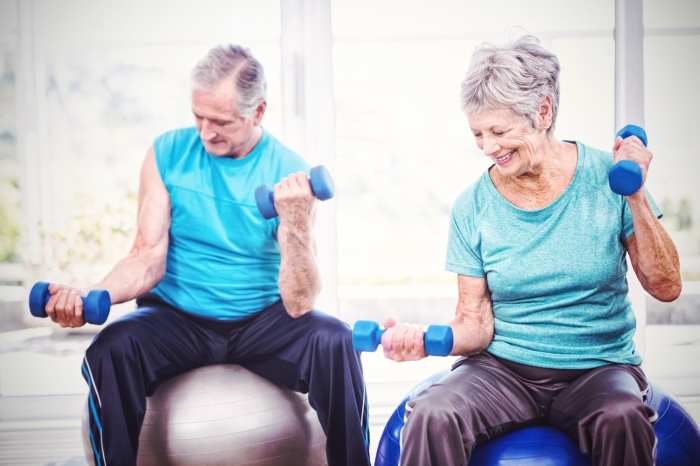Fitness Tips for Seniors to Stay Active and Healthy: As we age, it becomes increasingly important to maintain our physical and mental well-being. Regular exercise can help seniors improve their mobility, reduce their risk of chronic diseases, and enhance their cognitive function.
This comprehensive guide will provide you with all the information you need to create a personalized fitness plan that is safe and effective for you. We’ll cover everything from choosing the right activities to staying safe while exercising.
Importance of Fitness for Seniors

As we age, our bodies undergo physiological changes that can impact our fitness. These changes include:
- Decreased muscle mass:This can lead to weakness and difficulty performing everyday tasks.
- Reduced bone density:This can increase the risk of fractures.
- Decreased flexibility:This can make it more difficult to move around and perform activities of daily living.
- Reduced cardiovascular fitness:This can make it more difficult to breathe and perform physical activities.
Regular physical activity can help seniors offset these changes and maintain their fitness. Some of the benefits of regular physical activity for seniors include:
- Improved mobility:Exercise can help seniors maintain their range of motion and flexibility, making it easier to perform everyday tasks.
- Reduced risk of chronic diseases:Exercise can help reduce the risk of heart disease, stroke, type 2 diabetes, and some types of cancer.
- Enhanced cognitive function:Exercise can help improve memory, attention, and problem-solving skills.
Types of Fitness Activities for Seniors
Seniors can engage in a wide range of fitness activities that cater to their abilities and preferences. These activities offer various health benefits while promoting an active and fulfilling lifestyle.
It is essential to consult with a healthcare professional before starting any new fitness program, especially for seniors with underlying health conditions.
Low-Impact Exercises
Low-impact exercises are ideal for seniors who may have joint pain or limited mobility. These exercises put less stress on the joints and can help improve flexibility, balance, and strength.
- Walking:A simple and accessible activity that can be done anywhere. It helps improve cardiovascular health, strengthen muscles, and boost mood.
- Swimming:A great full-body workout that is easy on the joints. It provides resistance training, improves flexibility, and can help with pain management.
- Yoga:A mind-body practice that combines gentle movements, stretching, and breathing exercises. It enhances flexibility, balance, and reduces stress.
Moderate-Intensity Exercises
As seniors gain strength and endurance, they can gradually incorporate moderate-intensity exercises into their routine. These activities can help improve cardiovascular health, increase muscle mass, and burn calories.
- Cycling:A low-impact activity that can be done indoors or outdoors. It strengthens the legs, improves cardiovascular health, and is suitable for seniors with knee or ankle problems.
- Tai Chi:A gentle martial art that combines slow, flowing movements and deep breathing. It enhances balance, flexibility, and reduces stress.
- Strength Training:Using weights or resistance bands to build muscle mass. It helps improve bone density, reduce the risk of falls, and increase mobility.
Tailoring Exercises to Fitness Levels
The type and intensity of fitness activities should be tailored to each senior’s fitness level and abilities. It is important to start gradually and listen to your body. Gradually increase the intensity and duration of exercises as you progress.
Seniors with limited mobility or chronic health conditions may need to modify exercises or work with a physical therapist to ensure they are safe and effective.
Creating a Personalized Fitness Plan
As you age, it’s more important than ever to stay active and healthy. Exercise can help you maintain your independence, improve your balance and coordination, and reduce your risk of chronic diseases such as heart disease, stroke, and diabetes. Creating a personalized fitness plan is the key to getting the most out of your workouts and staying motivated.
Consulting with a Healthcare Professional
Before you start any new exercise program, it’s important to consult with your doctor. They can help you determine if you have any underlying health conditions that need to be considered and make sure that the exercises you choose are safe for you.
Setting Realistic Goals
When setting fitness goals, it’s important to be realistic. Don’t try to do too much too soon. Start with small, achievable goals and gradually increase the intensity and duration of your workouts over time. For example, if you’re new to exercise, start with walking for 30 minutes three times per week.
As you get stronger, you can increase the duration or intensity of your walks.
Tracking Progress
Tracking your progress is a great way to stay motivated and see how far you’ve come. Keep a journal of your workouts, including the date, time, duration, and intensity of each workout. You can also use a fitness tracker to track your progress.
Staying Motivated
Staying motivated can be challenging, but there are a few things you can do to make it easier. First, find an activity that you enjoy. If you don’t enjoy your workout, you’re less likely to stick with it. Second, set realistic goals.
If your goals are too ambitious, you’re more likely to get discouraged and give up. Third, find a workout buddy. Having someone to work out with can help you stay motivated and accountable.
Nutrition and Fitness for Seniors: Fitness Tips For Seniors To Stay Active And Healthy
Maintaining a healthy diet is crucial for seniors engaging in fitness activities. Nutritional needs change with age, and it’s essential to adapt eating habits to support physical well-being.
As seniors become more active, their energy requirements increase. Consuming adequate calories from nutrient-rich foods is vital for maintaining energy levels and supporting muscle recovery.
Healthy Eating Habits for Active Seniors
- Increase protein intake:Protein is essential for building and repairing muscle tissue. Aim for 1.2-1.6 grams of protein per kilogram of body weight daily.
- Consume whole grains:Whole grains provide sustained energy and fiber, promoting satiety and supporting digestive health.
- Hydrate adequately:Staying hydrated is crucial for overall health and fitness. Drink plenty of water throughout the day, especially before and after workouts.
- Limit processed foods:Processed foods often contain high levels of unhealthy fats, sodium, and sugar, which can hinder fitness progress.
- Choose lean protein sources:Lean protein sources, such as fish, poultry, and beans, provide essential amino acids without excess fat.
Sample Meal Plan for Active Seniors
| Breakfast | Lunch | Dinner | Snacks |
|---|---|---|---|
| Oatmeal with berries and nuts | Grilled chicken salad with whole-wheat bread | Salmon with roasted vegetables | Fruit, yogurt, or trail mix |
| Whole-wheat toast with peanut butter and banana | Tuna sandwich on whole-wheat bread | Lentil soup with whole-grain bread | Veggies with hummus |
| Scrambled eggs with whole-wheat toast | Quinoa salad with grilled chicken | Grilled turkey with sweet potato and broccoli | Popcorn, fruit salad |
Staying Safe While Exercising

Maintaining an active lifestyle as a senior brings numerous benefits, but it’s crucial to prioritize safety to prevent injuries. Understanding common risks and adopting appropriate strategies can help ensure a safe and enjoyable fitness journey.
Identifying Common Risks and Injuries
- Muscle strains and sprains:Overexertion or improper form can strain muscles or ligaments, causing pain and discomfort.
- Falls:Seniors are more susceptible to falls due to balance issues and reduced reflexes. Slippery surfaces, poor lighting, and inadequate footwear can increase the risk.
- Cardiovascular issues:Exercise can put stress on the heart, especially for seniors with underlying heart conditions. Chest pain, shortness of breath, or dizziness should not be ignored.
Strategies for Preventing Injuries
To minimize the risk of injuries, seniors should:
- Warm up properly:Begin with light cardio and gentle stretching to prepare muscles and joints for activity.
- Cool down gradually:After exercise, slow down gradually with light cardio and stretching to prevent muscle stiffness and soreness.
- Use proper form:Maintain correct posture and technique during exercises to reduce strain on muscles and joints.
- Listen to your body:Pay attention to any pain or discomfort. Stop exercising and consult a healthcare professional if necessary.
Importance of Seeking Medical Attention
It’s crucial to seek medical attention if you experience any of the following symptoms during or after exercise:
- Chest pain or discomfort
- Shortness of breath
- Dizziness or fainting
- Persistent pain or swelling
Ignoring these symptoms can lead to more serious health issues. By following these safety guidelines, seniors can enjoy the benefits of exercise while minimizing the risk of injuries.
Social Aspects of Fitness for Seniors
Participating in fitness activities offers numerous social benefits for seniors. These activities provide opportunities to connect with like-minded individuals, build relationships, and foster a sense of community. Social interaction can also enhance motivation and make fitness more enjoyable.
Group Exercise Classes, Fitness Tips for Seniors to Stay Active and Healthy
Group exercise classes tailored to seniors, such as SilverSneakers, are designed to be accessible and engaging. These classes often incorporate low-impact exercises, music, and social interaction. They provide a structured environment for seniors to socialize while improving their physical well-being.
Community Programs
Community centers and senior centers often offer fitness programs that cater to seniors. These programs may include walking groups, tai chi classes, and other activities that encourage socialization. They provide a safe and supportive environment for seniors to connect with their peers and stay active.Social
connections can significantly enhance the motivation and enjoyment of fitness for seniors. Interacting with others can provide encouragement, accountability, and a sense of belonging. This can make fitness feel less like a chore and more like a rewarding and enjoyable experience.
Technology and Fitness for Seniors
Technology has become an integral part of our lives, and seniors are no exception. Fitness technology can be a great way to help older adults stay active and healthy. From fitness apps to wearable devices, there are a variety of tech tools available that can support seniors in their fitness journeys.
One of the biggest benefits of fitness technology for seniors is that it can help them stay motivated. Many fitness apps and devices track progress, set goals, and provide feedback, which can help seniors stay on track with their fitness goals.
Additionally, some fitness trackers can also monitor sleep and nutrition, which can provide seniors with a more comprehensive view of their overall health.
Fitness Apps
There are a variety of fitness apps available that are designed specifically for seniors. These apps often include features such as:
- Exercise videos and instructions
- Fitness tracking
- Goal setting
- Social support
Wearable Devices
Wearable devices, such as fitness trackers and smartwatches, can also be a great way for seniors to stay active. These devices can track steps, heart rate, and other fitness metrics. Some wearable devices also offer features such as GPS tracking and sleep monitoring.
Online Resources
In addition to fitness apps and wearable devices, there are also a number of online resources available that can support seniors in their fitness journeys. These resources include:
- Exercise videos and tutorials
- Fitness articles and blogs
- Online fitness communities
Technology can be a great way to help seniors stay active and healthy. By using fitness apps, wearable devices, and online resources, seniors can find support, motivation, and information to help them achieve their fitness goals.
Concluding Remarks
By following these tips, you can stay active and healthy well into your golden years. So what are you waiting for? Get started today!


